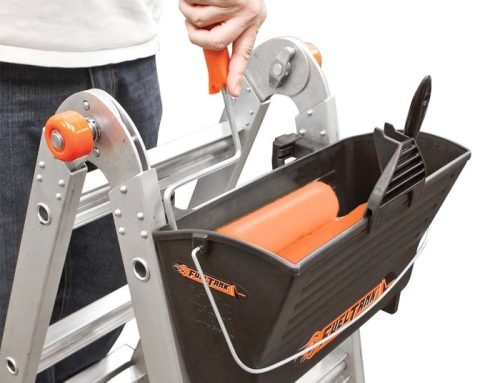Working at height using a ladder can be uncomfortable if you are up there for long periods of time. Balancing puts a strain in your back and legs, plus the soles of your feet start to hurt after being on the rungs for some time. Remaining in one position for any length of time can also cause sore and stiff muscles, which can lead to further pain and joint or muscle problems.
It's important, therefore, to take precautions against some of these common problems, so here are our top tips:
- Wear sturdy soled shoes or work boots that help support your ankles. Gel or cushioned insoles can help spread the force of the rungs pressing into your feet. Shoes and boots should have laces, so they can be firmly tied on – slip on shoes or ones which fit loosely can be dangerous on a ladder as they can slide off or cause you to slip as you ascend or descend.
- Wear gloves. This is especially important in the winter, but also in the summer as sweaty palms won't grip the stiles so well. In the winter a robust pair of gloves helps with grip, as well as keeping your hands warm – cold, stiff hands won't grip well either.
- Schedule frequent breaks so you can stretch and warm up the muscles. Use this time to have a well-deserved cuppa and see the progress of your work from a different angle – you might notice something from the ground that you can't see while you're up the ladder.
- Ensure you are in good shape before using a ladder. If you're feeling weak, tired or slightly under the weather, the strain of climbing a ladder and the lack of stamina to stand up there for long enough can make you feel worse and lead to avoidable injuries. If you are recovering from an injury be sensible and don't do anything that hurts or that might make your injury flare up again.
- Avoid the coldest and darkest parts of the day. Having enough light is vital so you can see what you're working on and you can also see the ladder clearly. In the winter, wait for the sun to come up and the day to warm up before using ladders as the frost on the ladder or on the ground could lead to slips and falls.
- Avoid over-reaching on the ladder. This is not only dangerous and is the prime cause of ladder related falls, but can also cause muscular strains and sprains. If the item you need is not within easy reach, then move the ladder to a more suitable place.
- Split the work between you and someone else if possible. This means progress will be strong without anyone tiring out. Having someone else present also means if an accident does happen there is help there to help and get help, if necessary.
- Use a ladder platform accessory to increase the area of the rung, for a more comfortable place to stand. These fit any ladder and are easy to attach and detach when needed.
- Don't rush a job. It is easy to make silly mistakes when you feel pushed for time, and at height silly mistakes can be catastrophic.
- Prepare, prepare, prepare. Know what you need to get the job done and make sure it is all available, and that you have a safe way of carrying equipment or tools up before you start.
Not all accidents are avoidable, but by sticking to these tips and using common sense you can decrease the risk significantly.






Leave A Comment
You must be logged in to post a comment.